Hello dear readers! Today, we are excited to share with you valuable information in the article “Revealing Knowledge: What is Future Trading?”. Whether you are just starting to learn about the financial market or have investment experience, understanding Future Trading will open up exciting and attractive investment opportunities. Join us in exploring the wonders of Future Trading, an investment tool that is becoming increasingly popular in the global financial world. Don’t miss out!
What is Future Trading?
Future Trading, also known as futures contract trading, is a popular investment method in the financial market. It allows participants to predict and benefit from future price fluctuations of an asset without needing to own that asset. With Future Trading, you buy or sell a futures contract with a specified delivery date.
I find the exciting part of Future Trading is the ability to profit from both directions of the market: up or down. This is different from directly buying assets, where you only profit when the asset’s price increases. Additionally, the use of financial leverage in futures trading allows you to control a large amount of assets with a small amount of capital, increasing the potential for profit but also increasing risk. It’s indeed a challenging and thrilling way to play!
However, it must be emphasized that futures trading requires extremely tight market analysis and risk management skills. It’s not a “get-rich-quick” investment model but a process that requires patience, continuous learning, and readiness to face market fluctuations. I always advise beginners to thoroughly research and even take courses on Future Trading before “jumping” into this market.
How Does Future Trading Work?
Future Trading, or futures contract trading, is an indispensable part of the modern financial investment world. It is a legal contract to buy or sell an asset at a specified date in the future at a pre-determined price. It might sound complicated, but in reality, it opens up flexible and diverse investment opportunities.
First, imagine you’re betting on the future price of an asset, which could be commodities, stock indices, currencies… When you buy a future contract, you don’t own the asset immediately. Instead, you’re buying the “right” to buy or sell that asset at a specified time in the future.
A noteworthy point is that future trading uses leverage, meaning you only need a small amount of money (known as margin) to control a large amount of assets. This creates significant opportunities for profit but also comes with high risk if the market moves unfavorably.
For those passionate about profiting from market fluctuations, future trading is indeed an exciting choice. However, it requires in-depth knowledge and market analysis skills to make smart investment decisions and effectively manage risk. Remember, every investment decision should be carefully considered, and understanding future trading is the first important step.
Pros and Cons of Future Trading
Advantages
The advantages of Future Trading not only come from the potential for profit but also its flexibility and diversity. Below are some highlights:
- Financial Leverage: With a small amount of margin money, you can control a large amount of assets, increasing the chances of high profit.
- Profit in Both Market Directions: You can profit from both the rise and fall of an asset’s price, not limited to buying low and selling high.
- Risk Hedging: Future contracts can be used to hedge risks for your investment portfolio, limiting losses when the market is unfavorable.
- High Liquidity: The futures market is highly liquid, allowing you to buy or sell contracts quickly and easily.
- Market Prediction: Offers the opportunity to “predict” the future price of assets, helping investors make strategic decisions. Diversification of Investment Portfolio: Adding future trading to your portfolio helps diversify and may reduce overall risk.
- Transparency and Regulation: Futures contracts are traded on regulated exchanges, increasing transparency and safety for investors.
- Clear Information: The terms of futures contracts are very clear and standardized, making it easy to understand and participate.
- Low Transaction Costs: Compared to some other investment forms, future trading often has lower transaction costs.
- Global Market Access: Allows access and investment in assets and markets worldwide, expanding investment opportunities.
These advantages make Future Trading an attractive investment choice for those looking to explore and take advantage of financial market opportunities.
Disadvantages
While Future Trading offers promising investment opportunities, it also comes with some disadvantages. Below are points to consider:
- High Leverage Risk: Although financial leverage can increase profit, it also increases the risk of losses, especially when the market moves unfavorably.
- Market Prediction Difficulty: Future trading requires a deep understanding of the market and the ability to accurately predict trends, which is not always easy.
- Careful Position Management: To avoid heavy losses, investors need to continuously monitor and manage their positions, which requires time and skills.
- Variable Liquidity: Depending on the contract and market, the liquidity of future contracts may not be stable, affecting the ability to buy or sell quickly.
- Technical Complexity: Understanding the technical terms and workings of future contracts can be quite complex for beginners.
- Margin Requirement: Investors need to maintain a certain amount of margin in their account to maintain a position, and may have to deposit more money if the price moves unfavorably.
- Legal and Counterparty Risks: Like any contract, future trading also carries risks related to the counterparty not fulfilling commitments or unforeseen legal issues.
- Regular Monitoring Needed: Markets can fluctuate strongly and quickly, requiring investors to constantly monitor and be ready to react.
These disadvantages do not necessarily diminish the attractiveness of future trading, but they are important factors to consider and prepare for before making an investment decision.
Different Types of Future Trading
Future Trading offers a variety of choices for investors, each with its own characteristics and opportunities. Below are some popular types:
- Commodity Futures Contracts: These contracts are based on commodities like oil, gold, coffee, or grains. Investors predict the future price of these commodities, using these contracts for hedging or speculation.
- Stock Index Futures Contracts: These contracts are based on stock indices like the S&P 500 or Dow Jones. Investors can use them to guess stock market movements or hedge their investment portfolios.
- Interest Rate Futures Contracts: Based on the interest rates of debt instruments like treasury bonds. Investors use these contracts to manage risks related to interest rate fluctuations.
- Currency Futures Contracts: Used to bet or hedge risks on foreign exchange rate fluctuations.
- Cryptocurrency Futures Contracts: A new and increasingly popular type, allowing trade based on the price fluctuations of digital currencies like Bitcoin, Ethereum.
Each type of futures contract has its own features, risks, and opportunities. Choosing the right contract depends on investment goals, market analysis skills, and understanding of specific markets. But regardless of the type, they all provide opportunities to optimize profits and manage risks in a volatile market environment.
Terms in Future Trading
In the world of Future Trading, grasping specialized terms is crucial for understanding the nature of trades and making smart investment decisions. Below are some terms you need to know:
- Futures Contract: This is a legal agreement to buy or sell an asset at a specified future time at a pre-determined price.
- Margin: The amount of money required to open and maintain a position in future trading. Margin ensures that you have the financial ability to fulfill the contract.
- Leverage: A feature that allows investors to control a large amount of assets with a small amount of capital, thus increasing the potential for profit as well as risk.
- Liquidity: The degree to which an asset or contract can be bought or sold in the market without significantly affecting the price.
- Settlement Price: The final price of a futures contract at the market’s close, used to calculate daily profit or loss.
- Daily Settlement: The process of calculating daily profit or loss based on the settlement price of the futures contract.
- Open Position: The number of futures contracts held by an investor.
- Take Profit/Loss: Orders placed to automatically sell or buy a contract at a certain price to lock in profits or limit losses.
- Offsetting Transactions: Trades made to buy or sell a futures contract with the aim of closing the current position.
Understanding and mastering these terms not only helps you track and analyze the market more accurately but also facilitates effective communication with other investors and financial experts. Investing time in learning and understanding each term is a crucial step to success in the challenging yet promising field of future trading.
What are Futures Contracts?
Futures Contracts, one of the most popular financial instruments widely used in the financial market, are agreements to buy and sell assets at a specified future time at a pre-agreed price. The objective of futures contracts can include commodities like oil and gold, agricultural products, or financial indices such as stocks and interest rates.
When engaging in futures contracts, you don’t directly own the asset immediately but instead, invest in the future price fluctuation of that asset. This allows investors to profit whether the asset’s price rises or falls, depending on their betting direction: buying (long) or selling (short).
Futures contracts are traded on professional exchanges and are standardized in terms of quantity, quality, and delivery time of the asset. An important feature of futures contracts is the use of leverage, meaning investors only need to place a small part of the total contract value (known as margin) to open a position. Leverage creates opportunities for high profit from a small position, but also implies significant risk if the market does not move as predicted.
In summary, futures contracts are a flexible and powerful investment tool, allowing investors to take advantage of opportunities in the financial market. However, due to their complexity and risk, investors need to be fully equipped with knowledge and analytical skills, as well as risk management, before participating in this investment form.
The Risks of Future Trading: Margin and Leverage
When it comes to Future Trading, two crucial concepts closely tied to risk cannot be overlooked: Margin and Leverage. These elements create the unique characteristics of Future Trading but also contain inherent risks that investors need to understand clearly.
Margin: In Future Trading, margin is the amount of money an investor needs to deposit to open and maintain a position. It’s only a small fraction of the total contract value, facilitating the use of leverage. However, this also means that if the market moves against predictions, the investor can lose the margin amount and might even need to deposit additional funds to maintain the position.
Leverage: Leverage allows investors to control a large amount of assets with a small amount of capital. This opens up opportunities for significant profits from minor market fluctuations. However, leverage also corresponds to high risk. A slight movement in the opposite direction can lead to rapid and substantial losses, especially when not using effective risk management measures.
Investors must be extremely cautious when using leverage, constantly monitor the market, and be ready to make quick decisions to cut losses. Simultaneously, understanding how to calculate margin and maintain margin requirements is essential to avoid unexpectedly liquidating positions.
Clearly, while margin and leverage are powerful tools in Future Trading, they also require investors to have skills, experience, and a clear strategy to manage risks and optimize opportunities. This is an important lesson and a fundamental aspect that anyone wishing to enter the volatile world of Future Trading must grasp firmly.
How to Start Future Trading
To start with Future Trading, you need to equip yourself with basic knowledge and be ready for this investment journey. Here are some necessary steps:
Understand Future Trading: First and foremost, you need to clearly understand what future trading is, how it operates, and related terminology. Learn about different types of futures contracts, how to calculate profits and losses, margin, leverage, and associated risks.
Determine Investment Goals: Before starting, clearly identify your investment goals and risk tolerance. Future trading can bring significant profits but also comes with high risk.
Choose a Reputable Trading Platform: Select a trading platform that is reputable and suits your needs. Ensure the platform is regulated by a competent authority and has good reviews from the investment community.
Open an Account and Deposit Margin: Register to open a trading account with the platform and deposit the required margin amount. Be aware that margin can fluctuate based on the contract value and market.
Learn and Practice: Before actual trading, spend time learning from courses, books, seminars, and specialized materials. Many trading platforms offer demo accounts for you to practice trading without risk.
Develop a Trading Strategy: Based on your knowledge and investment goals, develop a clear trading strategy. This includes determining when and how you will enter and exit trading positions, as well as how you will manage risk.
Monitor and Evaluate: Once you start trading, closely monitor the market and periodically evaluate your strategy. Be prepared to adjust your plan as necessary and continuously learn from experience.
Starting with Future Trading requires careful preparation and a thoughtful approach. Don’t rush into it without proper preparation, as this can lead to significant losses. Approach it systematically and confidently, step by step, to maximize the opportunities that Future Trading offers.
Conclusion
Dear readers, we hope that through the article “Revealing Knowledge: What is Future Trading?”, you have gained a deeper and comprehensive understanding of this challenging yet exciting form of investment. Future Trading is not just a game of numbers but also about astute assessment, judgment, and risk management. Remember, while it has the potential to bring high profits, it also comes with considerable risks. Therefore, equipping yourself with knowledge and skills, along with cautious decision-making, is the key to success. We wish you luck and success on your investment journey. Continue to follow our blog for more useful knowledge and information!








